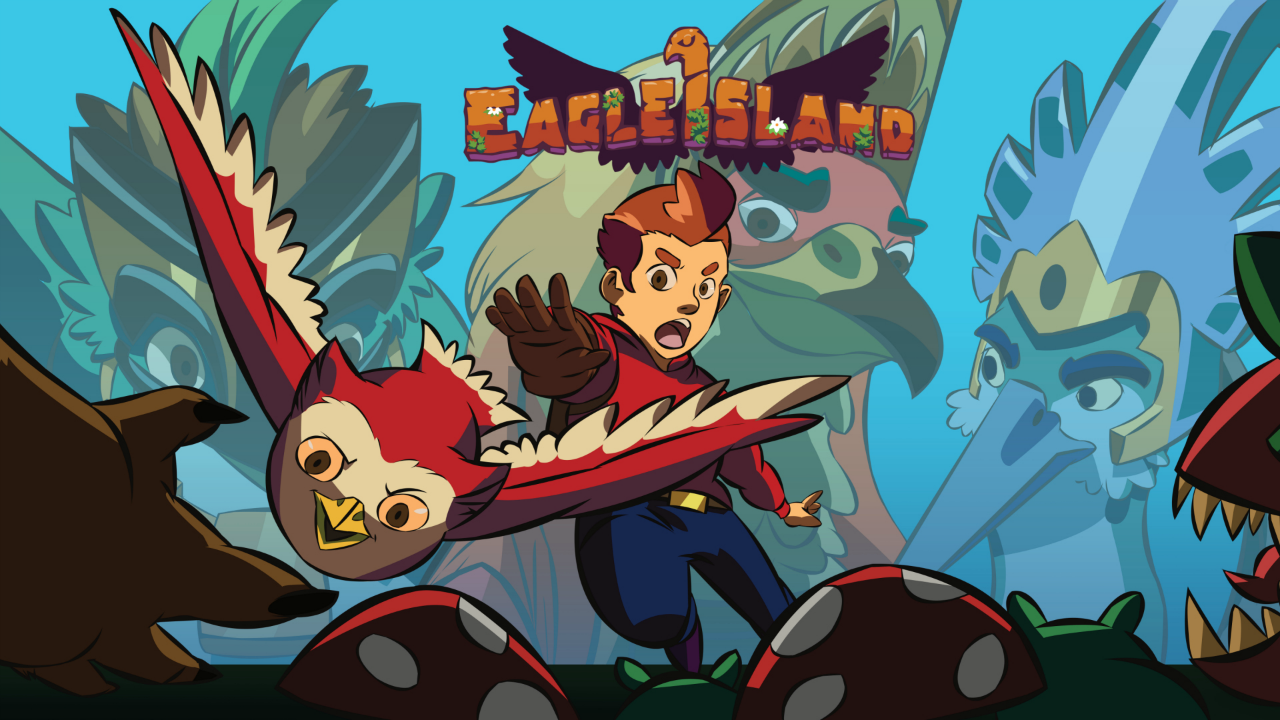Eagle Island is a curious action-adventure platformer, one that playfully camouflages its intentions behind a colorful, pixelated world, and reveals its roguelike self shortly after your expedition of the mysterious island begins. If you are willing to explore its lush and incredibly detailed world, you will discover that Eagle Island is one of the most rewarding and satisfying gaming experiences of 2019.
Eagle Island begins with a young boy named Quill and his owl companions Koji and Ichiro seeking adventure on the high seas. A sudden lightning storm wrecks their ship and leaves the trio stranded on the titular island. As you explore this exotic new world, the ominous shadow of a gargantuan bird-like beast named Armaura looms overhead. It isn’t long before Armaura swoops in and captures Ichiro, setting in motion a desperate rescue mission to recover Quill’s feathered friend. Shortly after beginning your adventure, you will encounter Dr Oliver Ornis, world famous ornithologist, who informs Quill that a similar fate has befallen his owl companion as well. He tasks you to find and rescue three ancient, elemental Totems before Armaura captures them.

One of the first things you will notice is how vibrant and full of life the island is. From minuscule critters burrowing up from the ground beneath your feet, to the microscopic fish that populate small pools of water, Eagle Island is absolutely teeming with life, almost as if to remind you that you are an outsider, and that this place existed long before your fateful visit. Such details are masterfully expressed through some of the most impressive pixel art I have ever seen. Colorful flora and fauna and massive decorative background structures are hand-drawn to perfection. Dynamic particle effects and lighting are simply breathtaking, and will often leave you standing still and gazing at the environment just to appreciate it a little longer.
When it comes to the layout, there is no doubt that developer Pixelnicks was inspired by the classics; there is a noticeable Banjo-Kazooie influence at play here, along with a healthy dose of metroid-vania for good measure. The island itself acts as a massive hub world wherein all individual levels are connected. You will find a variety of environments to explore: snow-filled peaks, subterranean lava pits, underground waterways, and rain-soaked forests to name a few. Each of these environments houses a series of temples which act as the game’s levels. Unlike the game’s hub world, temples are procedurally generated. Everything from the map to item/enemy placement are completely randomized, meaning you will have to rely more on skill and less on memorization to make it through each level alive. Fortunately, you have access to one of the most fun gameplay mechanics ever created: falconry.

Eagle Island controls like an absolute dream and before you know it, you’ll be pulling off some pretty sweet-looking maneuvers. Being able to jump and launch attacks in mid-air without ever touching the ground, and then double-jumping from your mid-air volley is something special. The one thing you are going to want to do though is change up the default control-scheme immediately. Maybe it’s just the years of NES muscle-memory talking, but my thumbs are accustomed to playing 2D platformers a certain way. So please, save yourself some aggravation and make ‘Y’ your attack button and ‘B’ your jump button; you’ll thank me later.
Taking gameplay cues from Yoshi’s Island, Quill can aim and hurl Koji in one of eight different directions. Precision is key here as missing a target will result in a slight delay before you are able to attack again. Striking an enemy, however, will make Koji swiftly return to you allowing for an instant follow-up. Chaining attacks will trigger a combo. The higher the combo, the greater the reward. Koji is also able to harness the ability of the ancient Totems by using one of their feathers. Totem Zephara grants the power of lightning, and allows Koji to zip through a string of enemies in the blink of an eye. Totem Magira, the fire elemental, adds an explosive blast to Koji’s attacks, and will destroy everything caught in its destructive radius. And Totem Icora freezes enemies with a chilling touch. You can cycle through your abilities by pressing and holding a button, which brings up a Secret of Mana-esque ring menu (told you it was inspired by the classics). You can also press the ZL/ZR to quickly rotate through your elemental endowments. Wielding such mighty talents comes at a cost however, as you will need sufficient Manaroc to utilize the power of each plume. And how do you obtain Manaroc? By performing combos, of course. These abilities make for some remarkable moment-to-moment gameplay. Knowing when to use each individual feather is key to your success and you will constantly cycle through your power-ups as the game constantly lobs enemies in your path. Totems aren’t the only thing that can bestow Quill and Koji with new and powerful abilities. Runestones can further augment you and your best bird buddy, but they too come will come at a certain cost.

Defeating enemies will provide you with two types of currency: Gold Seed and Silver Coin. Gold Seed can be used to open chests with a number value above it which indicate its cost. Such chests contain Runestones which can apply momentary yet mighty buffs to both Quill and Koji. Silver Coin on the other hand, can be used to purchase Runestones, and replenish Manaroc and lost health at shops scattered throughout each level. The Bargain Runestone for example will allow you to open chests at a discounted price while Charm opens your next three chests at absolutely no cost. Iron Beak will double Koji’s damage output (great for boss battles), and Boost extends his range. You can purchase Runestones that will buff your elemental abilities as well. Energize for instance makes Quill run faster, Blast Zone increases your blast radius, and Ice Explode causes frozen enemies to violently burst and take out surrounding foes. Don’t get too attached to any of these effects however, as they are all temporary. The longevity of each buff varies with each Runestone. Extra Heart – which grants you with an additional unit of health – will last for a substantial amount of time while Invulnerability runs out in a matter of seconds. It adds a layer of urgency to the gameplay for as much as you want to explore every nook and cranny, you don’t want to dawdle either. Believe me, there is nothing worse than working your way through a level with a two Extra Heart Runestones equipped only for them to shatter a few screens before a boss encounter. And given how challenging the game can be at times, you are going to want to cling onto every drop of health for dear life.
To put it plainly, Eagle Island is not for the weak. On the game’s Core Rules settings, you can only take three hits before you die. Don’t expect any checkpoints or any save rooms to record your progress in each level either. It is a one-shot deal, my fine-feathered friends. So if you die, you have to restart the temple all over again. And you can kiss your accumulated Gold Seed and Silver Coin goodbye as well. Fortunately you can change up the rules at any given moment to make the game a bit easier…but where’s the fun in that? The challenge is very reminiscent of retro games of the Nintendo/Super Nintendo era. In a lot of ways, Eagle Island feels like it was ripped right from the early 1990’s. And yet in other ways, it completely subverts your expectations, and I can think of no better example than the game’s presentation.

When I think of cute, sprite-based platformers, I think of games like Kirby’s Adventure. And when I think of Kirby, I think of upbeat tunes that are super-catchy, the ones that you find yourself humming while in the shower. But Eagle Island isn’t like that at all. Eagle Island is all about setting a specific tone and atmosphere. Instead of lighthearted beats, Eagle Island opts for a cinematic approach and the result is an ambient, and unnerving soundtrack that underscores your adventure. It goes hand in hand with the game’s storytelling. Without giving away too much, what starts off as a seemingly traditional platformer turns out to be anything but. The game is also filled with a surprising amount of cinematic moments. From manic mine cart sequences and outrunning blazing forest fires, to navigating underwater passageways and facing massive screen-filling bosses, Eagle Island is an interactive thrill ride that never ceases to amaze. It soars above the competition and takes the roguelike genre to daring new heights.
Priced at $19.99, Eagle Island is a must-have title for Nintendo Switch owners. It took me nearly 40 hours to complete 100% of the main game. Each of the game’s 18 levels houses a secret Eagle Coin. Collecting each of these coins unlocks the game’s true last level and arguably most challenging boss fight. On top of that, the game offers a Rogue Mode for added challenge, and a Boss Rush Mode. And trust me, you are going to want to unlock that Boss Rush Mode considering how awe-inspiring some of these bosses look. The game also promises Weekly Challenges so you will always have something new to look forward to.
A review key was provided by Screenwave Media for the Nintendo Switch.






